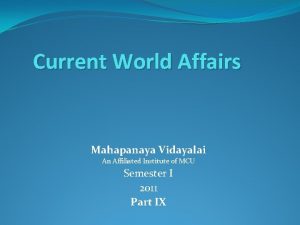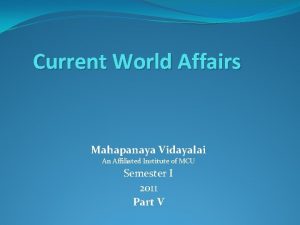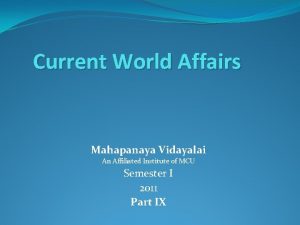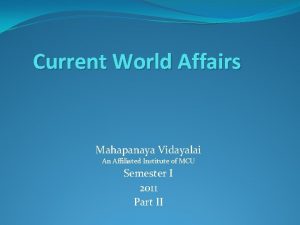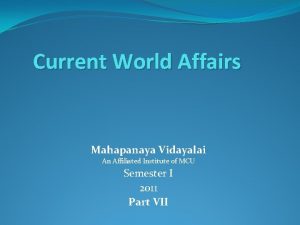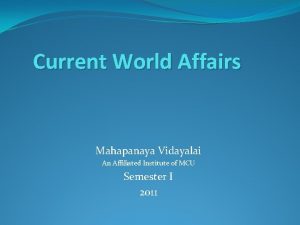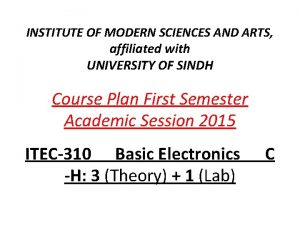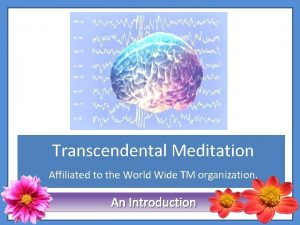Current World Affairs Mahapanaya Vidayalai An Affiliated Institute



























- Slides: 27

Current World Affairs Mahapanaya Vidayalai An Affiliated Institute of MCU Semester I 2011 Part VIII

Buddhism and Psychology Meaning of Psychology üThe word "psychology" is the combination of two terms - study (ology) and soul (psyche), or mind. üPsychology is the science of behavior and mental processes. üThe scientific study of the way the human mind works and how it influences behavior, or the influence of the particular person character on their behavior (Cambridge International Dictionary of English). üTo summarize, psychology can be defined as a branch of scientific study that focuses on the mental life and behavior of humans and animals

History of Psychology The study of psychology in a philosophical context dates back to the ancient civilizations of Egypt, Greece, China, India and Persia. German physician Wihelm Wund is credited with introducing psychological discovery into a laboratory setting. Known as the "father of experimental psychology”, he founded the first psychological laboratory. Sigmund Fraud , Karl Jung contributed in modern psychology.

Psychological approaches §Behaviorism §Psychoanalytic §Cognitivism § Humanistic § Biological

Behaviorism approach q. Behaviorism approach stated that psychologists do not have to consider mental events (conscious and unconscious). q. All aspects relating to a person’s behavior are influenced by the environment rather than by internal factors. q. Behavior is a series of responses that happens when there are stimuli. This approach is also known as stimulus-response psychology.

Pavlov’s Experiment

Psychoanalytic approach q. The psychoanalytic approach was based on the belief that human behavior is influenced by unconscious psychological processes which we are not aware of. q In other words, our behavior is based on internal conflicts, impulses, desires and motives which we are not aware of. q. This approach assumes that all behavior, normal and abnormal, is the result of the interaction between genetic and environmental factors. Both factors affect behavior by influencing the conscious and unconscious psychological processes. q. Sigmund Freud (1856 -1939), is the most well-known psychoanalytic theorist. His ideas have continued to influence other psychoanalytic theorists. His theory of personality structure divided the psychic structure into three categories: id, ego and superego. Freud believed that each of these entities were responsible for each set of psychological operation

Id, Ego and Super ego

Id q. The id is the source of motivation and desire that are inherited, primitive, selfcentered, and does not have the influence of the real world. q. The id consists of all the inherited (i. e. biological) components of personality q. The id is the impulsive (and unconscious) part of our psyche which responds directly and immediately to the instincts. The personality of the newborn child is all id and only later does it develop ego and super-ego. q. The id demands immediate satisfaction and when this happens we experience pleasure, when it is denied we experience ‘un pleasure’ or pain. The id is not affected by reality, logic or the everyday world. On the contrary, it operates on the Pleasure Principle which is the idea that every wishful impulse should be satisfied immediately, regardless of the consequences.

Ego q. The ego is responsible for and controls motivation and primitive urges so that they follow more closely the situational requirements. The ego slowly takes the responsibility to turn the primitive motivation of the id to follow the moral requirements and ethical standards of the community. q. Initially the ego is “that part of the id which has been modified by the direct influence of the external world”. q. The ego develops in order to mediate between the unrealistic id and the external real world. Ideally the ego works by reason whereas the id is chaotic and totally unreasonable. q. The ego operates according to the Reality Principle, working our realistic ways of satisfying the id’s demands, often compromising or postponing satisfaction. q. Like the id, the ego seeks pleasure and avoids pain but unlike the id the ego is concerned with devising a realistic strategy to obtain pleasure. q. Freud made the analogy of the id being the horse while the ego is the rider.

Superego §The superego incorporates the values and morals of society which are learnt from one's parents and others. § The superego's function is to control the id's impulses, especially those which society forbids, such as sex and aggression. §It also has the function of persuading the ego to turn to moralistic goals rather than simply realistic ones and to strive for perfection. §Behavior which falls short of the ideal self may be punished by the superego through guilt. The super-ego can also reward us through the ideal self when we behave ‘properly’ by making us feel proud.

Cognitive Approach q. The cognitive approach focuses on the process of human thinking such as perception and assumption, cognition, meta cognition, critical and creative thinking, learning skills, and motivation. q. Cognitive psychologists try to understand the processes involved and how they operate. q. These psychologists believe that the internal events that happen within an individual must be studied if his behavior in total were to be understood. q. This approach differs from the psychoanalysis approach that focuses on unconscious thought and the behaviorist approach that focuses on environmental factors and behavior.


Humanistic Approach q. This approach stated that the humans are free and good individuals with the potential to develop and with targets to achieve. q. Humans are motivated to act because they have desires and needs. q. According to this approach, humans are always active and do not wait to be acted upon. q. The study of psychology is to help humans to maximize their potential for their psychological development.

Maslow’s hierarchy of needs Maslow’s Hierarchy of Needs q. Physical Needs Need of food, water, shelter, oxygen and sleep q. Safety Needs Need for safety and security q. Belongings and Love needs Need for love, acceptance and belongings q. Esteem needs Need for achievement, education, competence and respect q. Need for self actualization q Need to realize our fullest potential

Biological Approach q. This approach is based on the assumption that humans are physical systems and must be understood from a physical angle. q. Among the things that have to be understood are the physiological condition and nervous system of the individual. q. Biological approach is the role of the central nervous system that is responsible for controlling the thoughts and movements of humans.

Buddhist perspective on human psychology

The structure of the mind Buddhists describe the person as composed of five skandhas ("aggregates"): 1. The body (rupa), including the sense organs. 2. Sensations and feelings (vedana), coming out of contact between sense organs and objects. 3. Perceptions and ideas (samjña), especially manifest in our ability to recognize things and ideas. 4. Mental acts (samskara), especially will power and attention. 5. Basic consciousness (vijñana). The last four are called naman, name, meaning the psyche. Mahayana Buddhism adds alayavijñana, “storehouse” consciousness, to the skandhas. This is similar to Jung’s idea of the collective unconscious. What is stored there are called bijas or seeds, which are inborn tendencies to perceive the world in a certain way and result from our karmic history. They combine with manas or ego to form the illusion that is ordinary existence. By quieting this ego and becoming less self-centered, your mind realizes the "emptiness" (sunyata) of all things. Then you have peace.

Mind is the forerunner of all (evil) conditions. Mind is their chief, and they are mind-made. If, with an impure mind, one speaks or acts, Then suffering follows one Even as the cart wheel follows the hoof of the ox. Mind is the forerunner of all (good) conditions. Mind is their chief, and they are mind-made. If, with a pure mind, one speaks or acts, Then happiness follows one Like a never-departing shadow.

How Buddhism Looks at the Mind ØBasic of other religions is GOD but the basis of Buddhism is mind. ØFrom the Buddhist viewpoint, mind or consciousness is the core of our existence. ØBuddhism focuses on the mind; for happiness and sorrow, pleasure and pain are psychological experiences. ØBuddhism interprets everything in the world as the manifestation of our mind. ØIn Buddhism, the root cause of human suffering, and other problems, is identified as the mind. ØBuddhism instructs sentient beings on how to recognize the mind, calm the mind and handle the mind. ØThe mind dictates a person's behavior. If a person's mind is pure, all his/her thoughts, speech and actions, will necessarily be pure. If a person's mind is impure, what he/she hears and sees becomes impure. Therefore, it is said in one sutra, "When the mind is impure, the being is impure; when the mind is pure, the being is pure. " ØAll the pain and suffering in this world are created by the mind.

Buddha often used simple stories to describe the mind. A summary of ten of them is listed below: • The mind is like a monkey, difficult to control • The mind is as quick as lighting and thunder: • The mind is like a wild deer, chasing after sensory pleasure all the time • The mind is like a robber stealing our virtues and merits: • The mind is like an enemy inflicting suffering upon us • The mind is like a servant to various irritations: • The mind is like a master having the highest authority: • The mind is like an ever-flowing spring: • The mind is like space without limit:

The attributes of the mind • Five basic psychological functions: mental and physical contact, attention, feeling, identification and analysis. • Five deliberately created mental conditions: aspiration, comprehension, memory, concentration and wisdom. • Eleven wholesome psychological states: trust, diligence, humility, remorse, no greed, no hatred, no ignorance, tranquility, attentiveness, equanimity, and no harm. • Six root afflictions: greed, hatred, ignorance, arrogance, doubt and incorrect view. • Twenty unwholesome psychological states: anger, hostility, irritation, conceit, deceit, flattery, arrogance, malice, jealousy, stinginess, no remorse, no regret, no trust, laziness, insensitivity, apathy, agitation, forgetfulness, incorrect perception and heedlessness. • Four neutral states of mind: remorse, sleepiness, applied thought and sustained thought.

Ways to Purify the Mind The following are treatments as prescribed in the Buddha's teachings: • A calm mind is an antidote to a busy mind: • A benevolent mind is an antidote to a malevolent mind: • A trusting mind is an antidote to a doubtful mind • A true mind is an antidote to a deluded mind: • An open mind is an antidote to a narrow mind: • A balanced mind is an antidote to a fragmented mind • An enduring mind is an antidote to an impermanent mind: • A non-attached mind is an antidote to an impulsive mind: In addition to these eight observations, we ought to cultivate a mind of patience, humility, thoughtfulness, filial piety, sincerity, honesty, innocence, purity, lovingkindness, forgiveness, joyfulness, charity, reverence, equanimity, forbearance, contrition, repentance, thankfulness, wisdom (prajna), compassion (a trait of a Bodhisattva) and enlightenment (a trait of a Buddha) to fully develop its boundless potential.

Buddhism's Contribution to Modern Psychology The Tripitaka consists of three parts: 1. Sutta Pitaka, which contains the discourses of the Buddha on various occasions throughout his preaching life; 2. Vinaya Pitaka, which contains the rules of discipline for the monks; 3. Abhidhama Pitaka, which contains highly systematized philosophical and psychological analyses, which were finalized in their present form about 250 B. C. All the Buddha's teachings deal with the mind, as shown in the multitude of sutras and sastras. Among them, the psychological understanding spoken of by the Mind-only (Yogacara) School is closest to its counterpart in today's psychology. The Yogacara view that the mind consists of eight consciousnesses clearly indicates that it is not made of a single element, but an interactive complexity of factors. These factors are the functions of the six sensory organs of the human body (eyes, ears, nose, tongue, body, and mental function) plus the consciousness which constantly grasps the "self" (the Manas) and the Alaya consciousness which collects and stores all karmic seeds of the mind in the ongoing cycle of birth and death of all sentient beings.

Jung divided the human psyche into three levels: conscious, individual unconscious and collective unconscious. The individual unconscious functions like a storage of memory, amassing a person's repressed psychological experiences and feelings. The collective unconscious, on the other hand, is the accumulation of the deepseated archetypes inherited by human beings over many generations. This idea is very similar to the formulation of the "Alaya Consciousness" in Buddhism. Maslow (1908 - 1970), it postulates that human needs can be divided into five stages. The highest stage is "self- actualization. " He borrowed concepts such as "correct feeling" and "enlightenment" from Buddhism to interpret the ideal state of self- actualization. Maslow often used the Buddhist term "Nirvana" to describe this special experience. He also stated that the notions of "Selflessness" and "True Self (Buddha Nature)" can assist people in attaining self-actualization and contributing to others in society.

Motivation The unenlightened person's behavior, it is said, is governed and driven by tanha, or craving, is given as the cause of "suffering" or unsatisfactoriness" in the Second Noble Truth. Tanha is classified into three basic forms: kama tanha (craving for sensory gratification); bhava tanha (craving for survival or continued existence); and vibhava tanha (craving for annihilation) In a further analysis of motivation, Buddhism identifies three factors that lead to unwholesome, or undesirable, behaviors. These are: raga (passion or lust); dosa (hatred or malice); and moha (delusion, or false belief) All unwholesome action is seen as deriving from a set of fundamental roots. Perception and Cognition Perception is based on twelve gateways or modalities (ayatana), six of these being the five sense organs plus the mind, or "inner sense, " and the other six being the objects of each of these (Samyutta Nikaya, II, 1884 -1898). The status of mind (mano) is special. It has the ability to reflect on the objects of the other senses, so in this way it is linked to the activity of all the senses (Kalupahana, 1987). Each combination of sense organ and its objects leads to a particular consciousness (vinnana)--for example, visual consciousness arises because of the eye and material shapes. When consciousness is added to each of the pairs of modalities, one gets eighteen factors of cognition, referred to as dhatus, or elements. The meeting of the three (i. e. , eye, material shape and visual consciousness) is contact; because of this contact arises feeling; what one feels, one perceives. (Majjhima Nikaya, 1, 1888 -1902)

 Unit 4 vocabulary affiliated
Unit 4 vocabulary affiliated Level e unit 4 vocab
Level e unit 4 vocab Affiliated ascertain attainment
Affiliated ascertain attainment Simon conway quiz
Simon conway quiz Be not entangled with the cares of this world
Be not entangled with the cares of this world What is noninvolvement in world affairs?
What is noninvolvement in world affairs? A national policy of avoiding involvement in world affairs
A national policy of avoiding involvement in world affairs World affairs challenge
World affairs challenge A balanced delta connected load having an impedance 20-j15
A balanced delta connected load having an impedance 20-j15 Difference between phase voltage and line voltage
Difference between phase voltage and line voltage N=nc exp(-eg/2kt)
N=nc exp(-eg/2kt) Ac systems lesson 4
Ac systems lesson 4 Drift current and diffusion current
Drift current and diffusion current What is diffusion current and drift current
What is diffusion current and drift current Q point
Q point Balanced y-y connection
Balanced y-y connection Holding current and latching current
Holding current and latching current Diffusion current formula
Diffusion current formula Establishing a shielded metal arc is often described as
Establishing a shielded metal arc is often described as Hazard based safety engineering
Hazard based safety engineering Mesh current method with current source
Mesh current method with current source World trade institute bern
World trade institute bern World research institute
World research institute Sas institute v world programming
Sas institute v world programming Green world international training center
Green world international training center World nuclear transport institute
World nuclear transport institute Hhs office of population affairs
Hhs office of population affairs Ministry of east african community affairs uganda
Ministry of east african community affairs uganda




























